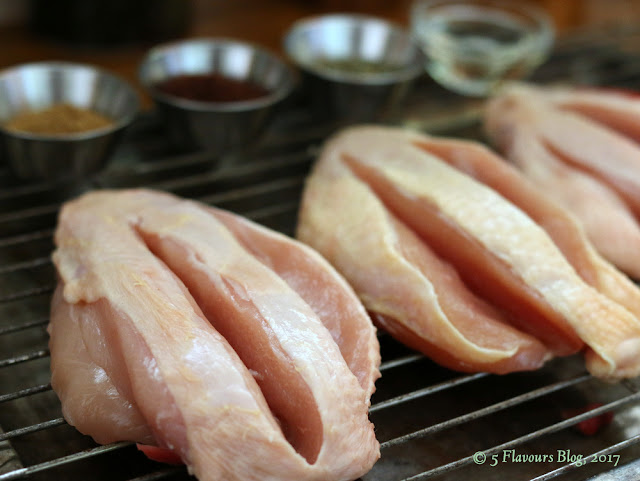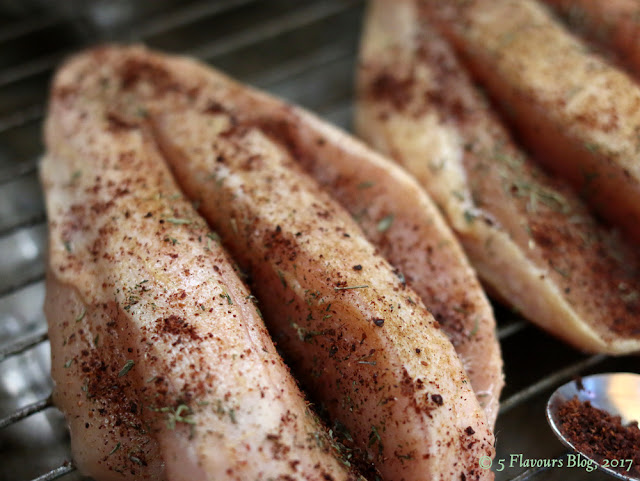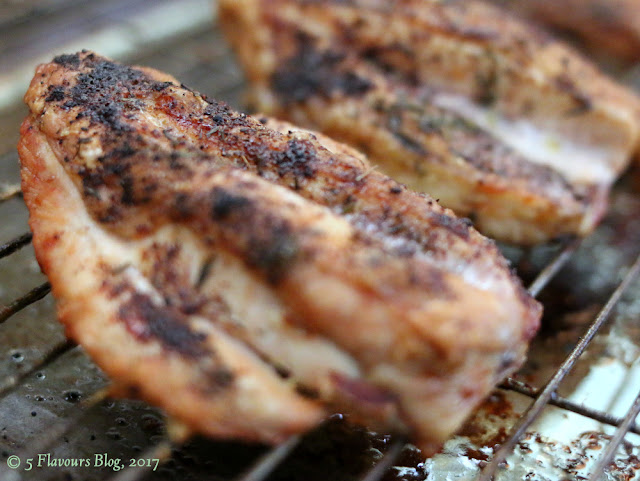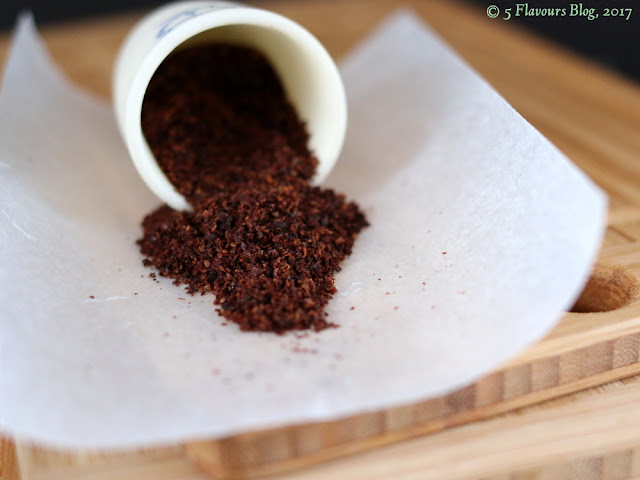Oven Roasted Chicken Mayonnaise
Why
such a somewhat unusual deviation from the universally boring,
boil-chicken-fillets-to-death-in-the-pot-and-slather-with-mayonnaise procedure?
Because it tastes better?, we want to elevate our standards?, we have pride in
ourselves?, we respect our ingredients?, need I go on?
We owe a great deal of debt, and respect, to the modern, mass produced
chicken. I harbor a deep and abiding soft spot for them.
We, the common city dwellers, realize maybe only partially how far the living
conditions of these ‘conveyer belt’ chickens (and their peers: the battery kept,
egg laying chicken) have improved over the past decade or so. In the past these animals stoically endured ages of maltreatment at the hands of big
conglomerates. Sensational (and often gruesome) media exposé’s have sensitized society
sufficiently to force the industry to vastly improve their practices. Of
course, not all producers were ‘evil’, but still ...
Naturally, our
modern, mass produced chickens differ significantly from their free ranging,
farm yard raised brethren – a direct consequence of our ever hungry, constantly
growing global population. I wonder how may of our present day Youth knows what
a real farm yard chicken tastes like and who will refuse the ‘untamed’ and ‘smelly’
thing on their plates? Let’s leave it at that.
I vividly recall my
dad’s free ranging Leghorns at our agricultural smallholding on the outskirts
of Port Elizabeth. By comparison, the modern, brine infused, chain store
chicken is lacklustre and flabby in both the taste and texture departments.
Yet, the humble chain store chicken has an unintended advantage over it’s farm
yard brother. It is a uniform, blank artist’s canvas upon which a talented cook
may paint flamboyantly with flavours, aromas, textures and techniques as and
how the muse leads him or her. Ironically, farm yard chickens are not nearly as
flexible or accommodating in this respect as the much maligned ‘conveyor belt’
chicken.
A variety of TV
cookery and food preparation programmes have trained and sensitized us to the
nature, styles and preferences of other cultures’ culinary practices. The
recent interest in – and popularity of – the ‘fusion cooking’ philosophy and practice is vivid proof of this
phenomenon (however twisted it sometimes became). The result? Our ordinary,
boring ‘conveyor belt’ chicken has progressed from a shy back roomer to a
metropolitan, world wise entity of which the level of elevation is purely and wholly
dependant on the skill, inspiration and creative urge of the modern cook.
This is one of my
takes on doing justice to the modern, mass produced chicken.
OVEN ROASTED CHICKEN MAYONNAISE
– PRINT RECIPE –
Recipe yields:
|
Preparation time:
|
3 – 4 Portions
|
± 120 minutes
|
Ingredients:
Chicken breasts, skin on,
bone in
|
± 500g / 3 Breasts
|
Lemon juice
|
30ml
|
Sumac
|
2.5ml
|
Dried thyme
|
2.5ml
|
Ground cumin
|
1.2ml
|
Mayonnaise, not too tangy
|
200g
|
Medium sized onion, finely
grated
|
½ onion
|
Sweet & sour gherkins,
finely diced
|
30g
|
Salt
|
5ml
|
Chopped garlic
|
2.5ml
|
Sumac
|
2.5ml
|
Dried sage
|
1.2ml
|
Ground bay leaf
|
0.5ml
|
Fine white pepper
|
0.5ml
|
Method:
1. Cut two deep incisions along the length of each breast. Splay
the breasts and cover lightly with lemon juice over the entire surface. Mix the
sumac, thyme and cumin. Sprinkle over
the skin side of each breast. Cover and marinate for 60 minutes in the
refrigerator.
2. Roast for 30 minutes skin side up, uncovered, in a preheated
convection oven at 170°C (340 deg Fahrenheit) or 35 minutes at 180°C (360 deg Fahrenheit)
in a normal, static oven. Remove and allow to cool for ± 15 minutes.
3. Debone and chop each
breast, roasted skin and all, roughly. Add the mayonnaise, grated onion,
gherkin, garlic and all the remaining ingredients. Mix thoroughly.
4. Serve and enjoy.
Sumac
Sumac is the dried and ground fruit of a Mediterranean shrub in the
genus Rhus. In it’s turn, the genus Rhus is a subset of the Anacardiaceae family – better known as
Team Cashew. The spice is widely used in Middle Eastern cuisines, particularly
those of Arabia, Turkey, the Levant and – most notably – Lebanon.
Traditionally, the spice is an important souring agent in these regions as
a general substitute for lemon, tamarind or vinegar. It is rubbed over chicken
or fish kebabs before roasting, used in casseroles or stews, and also forms a
component of marinades and salad dressings, amongst others.
The intensely purplish-red, ground spice has a sharp, pungent smell;
similar to brown vinegar without the sour element (if that was possible). The
aroma is unique: mild, but definitely flavourful, aromatic and somewhat lemony –
ideal for relatively bland proteins such as chicken, white fish or young pork.
It marries very well with lemon, thyme, oregano, thyme and sage, in any
combination.
In my experience, the spice is not oven stable. It fades dramatically
over the 35 – 50 minutes baking or roasting required for most cutlets of
chicken, pork or beef. Therefore, sprinkle a second shot of sumac over the
rooster or pig just before it exits the oven, or immediately thereafter, for
maximum impact.
Keep the spice thoroughly sealed in an airtight container away from
direct sunlight. Also keep in mind that the marinade it is used in, will stain
– aprons, dish cloths, synthetic kitchen working surfaces, etc. Sumac’s
staining capabilities were already well known in the 18th century
when bags of the ground spice were kept apart from the rest of the cargo.
Apparently it stains unpolished marble aggressively.
Sumac is locally, in South Africa, a specialist spice. Although it’s
popularity is growing progressively (judging by local magazine recipes and TV
cookery shows), I have not yet seen it in the general chain stores except some Woolworths
branches. However, the larger Food Lovers Market’s or dedicated spice purveyors
will probably also stock it. My supply comes from Samoosa & Spice,
Jacaranda Centre, Rietfontein, Pretoria, (012) 330 3086.
Comments:
¨
Bone-in chicken breasts bake and roast considerably better
(moisture content and texture wise) than those clinical and
totally-removed-from-any-living-organism, deboned and de-skinned trays of
chicken fillets that present themselves so innocently and neatly on supermarket
refrigerator shelves. Similar to dead fish ...
¨
The crisply roasted, chopped chicken skin lends a rich,
savory tone to the final dish. Leave out if your conscience rebels against the
touch of cholesterol. De-skin the breasts prior to Method step 1.
Sources:
1. “Sumaq”; https://en.wikipedia.org/wiki/Sumac, accessed on 2017.06.09.
2. COOKING WITH SPICES; Heal, Carolyn & Allsop, Micheal; Panther Books; Granada Publishing Ltd., Great Britain, 1985.
© RS Young, 2017
– RECIPE INDEX PAGE –
Follow Me on Facebook
Note:
Post
updated on 2024.02.24 to include:
1.
The updated Recipe for downloading as a PDF file, and
2. Recipe Title and Print Recipe, Recipe Index and Facebook & Pinterest follow links.








Comments
Post a Comment